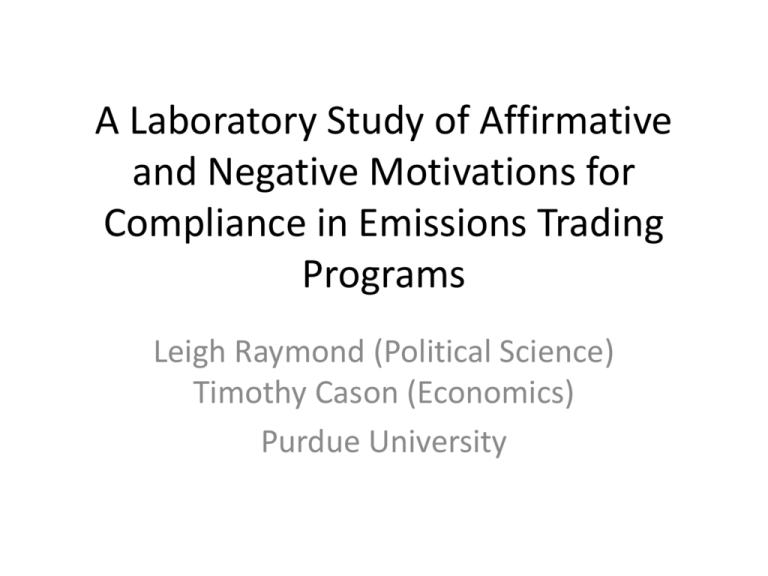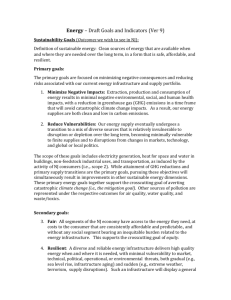A Laboratory Study of Affirmative and Negative Motivations
advertisement

A Laboratory Study of Affirmative and Negative Motivations for Compliance in Emissions Trading Programs Leigh Raymond (Political Science) Timothy Cason (Economics) Purdue University Motivation and Research Rationale • Self-reporting and imperfect enforcement are becoming more important in emissions trading programs – Continuous emissions monitoring is often infeasible • What motivates honest reporting? – Negative motivations: fear of punishment for violations – Affirmative motivations: personal sense of a rule’s legitimacy or morality determines compliance • Experiment varied legitimacy and fairness through manipulations of permit endowments & framing Research Method • Laboratory emissions permit market with voluntary reporting of emissions each period – “hard case” for finding influence of affirmative motivations, since financial incentives were real but environmental and political consequences were not • Simple (random inspection) enforcement mechanism, with inspection probabilities varied as a treatment variable • Pre- and post-experiment surveys used to assess subjects’ normative beliefs Specific Hypotheses • (H1) Subjects will report emissions more honestly than simple calculations of economic self-interest dictate. • (H2) Subjects will rate egalitarian allocations as fairer than grandfathering or auctions. • (H3) Subjects rating their allocations as “unfair” will be significantly less likely to comply. • (H4) Subjects who express an affirmative motivation to obey “fair” laws in general, and who assess the experiment’s rules as “fair,” will be more likely to comply. • (H5) Subjects who express a general affirmative duty to obey laws will be more likely to comply. • (H6) Subjects who approve of emissions trading in general as a legitimate policy will be more likely to comply. Experiment Design Details • 11 rounds of trading and reporting in each session – Step 1: permit allocation (constant within sessions) – Step 2: computerized continuous double auction emission permit trading – Step 3: pollution abatement decision – Step 4: emissions reporting decision – Step 5: enforcement and fines (random inspection) • 8 traders per session (2 or 3 sessions conducted simultaneously) • Student subject pool – Perhaps biasing downwards the impact of framing? Marginal Abatement Costs and Permits • 64 permits allocated; prices in the range E$208-212 clear the market with perfect compliance. Figure 1: Avoided Marginal Abatement Costs and Total Permits Available 400 Cost (Experimental Dollars) . 350 Permits Available 300 250 Avoided Abatement Costs 200 150 100 50 0 1 11 21 31 41 51 61 71 81 91 101 111 121 131 141 151 Quantity of Permits or Abatement Experimental Treatments • 2×2×2 design (8 treatments) • High vs. Low enforcement (always E$400 fine per unit) – 50% vs. 25% inspection probability • Environmentally Framed vs. Neutral (“Unframed”) – “Manager of a power plant that…burns fossil fuel to produce electricity which pollutes the atmosphere” vs. “choose a number…report your number choice” • Equal vs. Unequal permit endowment – Unequal explained in Framed as grandfathered based on higher historical emissions and pollution control costs • 5 sessions in each treatment cell + 1 extra session – 328 total subjects; Ave. pay US$29, total time ~2 hours Computerized using zTree Any trader could either buy or sell, and by holding permits they could avoid paying higher marginal abatement costs. Results: Negative Motivations • (H1) Subjects will report emissions more honestly than simple calculations of economic self-interest dictate. • Table 1: percent of noncompliant emissions reports – Noncompliance is clearly higher with low monitoring Neutral Frame “should” be much higher Environmental Frame Unequal Equal Unequal Equal Endowments Endowments Endowments Endowments Low Monitoring 39.5 31.8 53.2 53.9 High Monitoring 11.1 12.7 36.4 31.4 Over one-third of subjects reported honestly in at least 10 of 11 periods with low monitoring Results: Fairness of Allocation Methods • (H2) Subjects will rate egalitarian allocations as fairer than those based on grandfathering or auctions. • Table 2: Allocation Fairness Ratings Very Unfair Somewhat Unfair Neutral Somewhat Fair Very Fair Don’t Know Which allocation most fair? Which allocation most unfair? Don’t Know Grandfathering 13% 32% 20% 26% 5% 5% Equal Shares 5% 18% 25% 36% 10% 5% Auction 12% 54% 23% 12% 38% 7% 46% 9% 25% 22% 21% 16% 10% 6% Results: Affirmative Motives from Morality • (H3) Subjects rating their allocation as “unfair” will be significantly less likely to comply. – Tobit models using the level of noncompliance as the dependent variable support this hypothesis • (H4) Subjects who express an affirmative motivation to obey “fair” laws in general, and who assess the experiment’s rules as “fair,” will be more likely to comply. – Tobit models indicate that subjects who indicate personal beliefs as a main motivation for misrepresenting emissions complied less; and – Subjects who believe in importance of following fair or just laws complied less in the neutral frame (Dependent variable: Total amount of noncompliance) Treatment Conditions and Endowment Indicator=1 if environmental context Indicator=1 if monitoring intensity is high Indicator=1 if subject has a high permit endowment Indicator=1 if subject has a low permit endowment Questionnaire Responses Indicator=1 if subject viewed own permit endowment as unfair Indicator=1 if subject indicated personal beliefs as main motivation for accurately reporting emissions Indicator=1 if subject indicated personal beliefs as main motivation for misrepresenting emissions in reporting Indicator=1 if subject agrees that he/she sometimes disobeys laws when the risk or consequences are low Indicator=1 if subject believes in importance of following fair or just laws Indicator=1 if subject believes in importance that obeying the law in general is the “right thing to do” Indicator=1 if subject viewed own permit endowment as unfair and believes in importance of following just laws Indicator=1 if subject is considers him/herself an "environmentalist" Indicator=1 if subject believes that global warming is an important issue Indicator=1 if subject correctly identifies a statement describing emissions trading and supports it as a policy All Treatments Neutral Context Environmental Context 27.98** (4.81) -23.39** (5.12) -23.22** (6.48) 11.84 (7.00) -37.86** (9.84) -37.64** (10.65) 4.11 (8.52) -16.55* (6.71) -17.16* (7.78) 19.43* (9.25) 34.85** (12.78) -14.31 (7.71) 35.00** (11.54) 8.61 (4.83) 2.53 (6.10) 1.85 (5.94) -25.02 (15.78) 6.16 (5.61) 0.90 (5.73) 4.53 (10.76) 39.07* (17.06) -15.25 (10.23) 50.67** (12.99) 10.74 (5.88) 14.61* (6.15) 3.27 (7.63) -31.00 (22.44) 3.19 (8.12) -10.46 (6.08) 27.78* (11.66) 41.49* (16.45) -11.57 (10.40) 12.81 (15.36) 9.97 (5.75) -4.80 (9.29) 4.14 (10.58) -29.87 (19.72) 6.62 (7.09) 14.97 (7.68) -4.36 (16.35) Results: Affirmative Motives from Legitimacy • (H5) Subjects who express a general affirmative duty to obey laws will be more likely to comply. – Subjects who agreed with the statement “sometimes I disobey laws when the risks…are low” reveal weaker motivations through legitimacy in general, but they comply less at only marginally significant levels • (H6) Subjects who approve of emissions trading in general as a legitimate policy will be more likely to comply. – No support for this. ET supporters do not comply more (and they actually comply less in the neutral context). Additional Compliance Results • Subjects with a low permit endowment, who are typically permit buyers, comply less in the environmentally framed treatment (as in Murphy & Stranlund, 2007) • Greater compliance observed among more risk averse subjects (independent lottery choice elicitation) and among US residents (Dependent variable: Total amount of noncompliance) All Treatments Neutral Environmental Context Context Demographic and Risk Preference Controls Indicator=1 if 8.59 14.09 2.46 subject is male (5.65) (10.57) (6.82) Indicator=1 if 1.40 -8.56 11.63 (6.21) (8.93) (8.15) -27.74** -41.60** -29.76** lived in US for more than 5 years (6.51) (9.16) (9.42) Grade point average (self reported) 7.03** -22.24** 9.86** (2.48) (8.29) (2.37) 4.74 -1.14 5.44 (2.62) (3.56) (4.32) Indicator=1 if subject receives -6.55 -7.56 -9.49 need-based financial aid (4.47) (4.42) (7.37) Indicator=1 if subject's lottery choices 10.76 4.10 17.53 indicate risk seeking preferences (8.08) (12.71) (10.66) -13.95** -6.89 -16.68** (5.30) (9.01) (6.02) subject is business major Indicator=1 if subject has Years of college Indicator=1 if subject's lottery choices indicate very risk averse preferences Permit Market Performance • Permit prices were greater in the high monitoring treatment, which featured more compliance. Figure 2: Average Median Permit Transaction Prices for Low Monitoring and High Monitoring Treatments 220 High monitoring 200 Low Monitoring 180 Low Monitoring Price Prices are significantly higher in sessions with more emissions control and compliance. High Monitoring 160 Full Compliance Equilibrium Range 140 120 100 0 1 2 3 4 5 6 Period 7 8 9 10 11 12 Environmental Framing • Hypothesis (H6) depends on subjects’ environmental policy attitudes, and other hypotheses depend on knowledge and preferences toward environmental regulations • Neutral framing is much more common in experimental economics – Recommended by Alm (1999), for example, since it obscures the experiment’s context and purpose—thereby increasing experimental control – Subjects could have very different attitudes towards the role of environmental regulation and emissions trading • We introduced non-neutral framing deliberately to activate these concerns Framing as a Treatment Variable • Some advocates of field experiments argue that neutral framing can reduce control if it leads subjects to invent their own context, which is unobserved to the experimenter – Bohm and coauthors often used environmental framing in experiments that employed subjects with field experience • Context framing appears most useful for expert subjects participating in field experiments, and has a greater impact on their behavior; so our surprising and large framing effect could actually understate the impact of environmental framing in the field Neutral Frame Environmental Frame Percent of noncompliant emission reports Unequal Equal Unequal Equal Endowments Endowments Endowments Endowments Low Monitoring 39.5 31.8 53.2 53.9 High Monitoring 11.1 12.7 36.4 31.4 Summary • We confirm the importance of affirmative motivations even in this “hard case” without real environmental consequences • Stronger support (for this subject pool) for egalitarian allocations than is reflected in political proposals • Surprisingly strong increase in noncompliance in the environmental framing treatment (as important as the fine!) – Environmental econ experiments should investigate further • Emissions trading policies that rely on self-reporting should consider legitimacy and affirmative motivations for compliance, especially when debating alternative allocation methods and building public support for policies like cap and trade Future Work • Add real environmental consequences of noncompliance to strengthen affirmative motivations (e.g., buying emissions offsets) • Include laboratory political processes (e.g., majority voting, negotiations, or rent seeking contests) to manipulate legitimacy of policy and allocation choice • Extend subject pool to non-students, including environmental managers • Investigate intermediate frames (e.g., a “firmmanager” but not in an environmental context) • In general, consider perceptions of the initial allocation as part of the policy design, since they apparently affect compliance incentives







